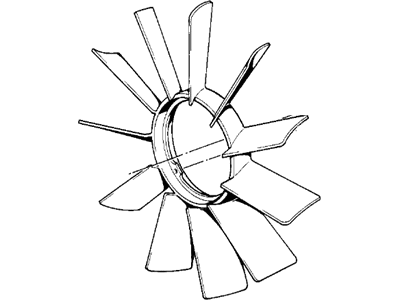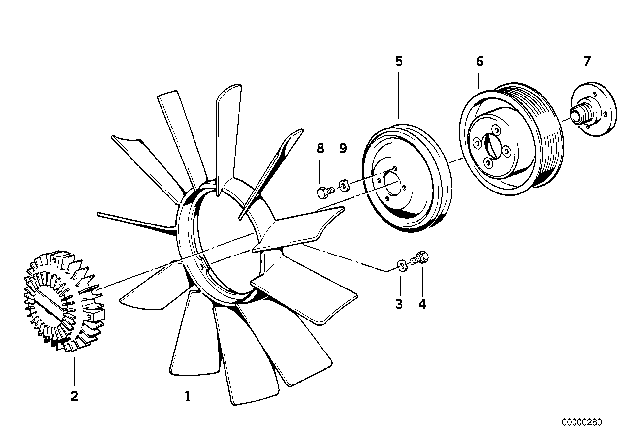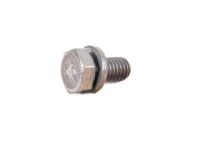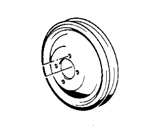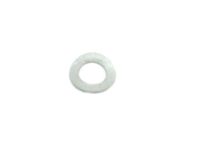The engine cooling fan can be electrically operated or belt-driven, attached to the water pump spindle. For those with a belt-driven fan, it must be removed before taking out the radiator. To protect the radiator, slide a thin piece of sheet metal or cardboard in the fan's place. First, note the radio security code and disconnect the negative battery cable. Next, remove the radiator trim cover fasteners, which may be screws or two-piece button-styled rivets. Lift the trim cover off after removing fasteners. On 6-cylinder models, remove the alternator cooling hose and rubber gaiter near the washer solvent reservoir, if present. On 4-cylinder models, find the fresh air duct locking clip behind the right headlight assembly, release it, and then remove the duct. For models with a belt-driven fan attached to the water pump: support the water pump pulley with a specific tool or thin pliers, loosen the fan coupling nut clockwise (it's a left-hand thread), remove lock pins from the upper fan shroud rivets, lift the fan shroud and fan assembly together away from the radiator, mark the cooling fan's position on the fan coupling, and remove the fan. For electric fan models, detach the fan electrical connector, remove shroud fasteners, lift the shroud and fan out, then remove the fan from its motor. Before reinstallation, check the drive belts and coolant hoses and replace any that are damaged. Ensure all electric connections are correct for electric fans and verify their operation. For belt-driven fans, inspect the fan clutch, ensure the fan is attached correctly, seat the shroud in its lower retainers, install the upper rivets, and install the fan assembly onto the water pump spindle counterclockwise. The fan clutch assembly has a left-hand thread. For easier installation, wrap a string around the fan clutch nut and pull it to rotate the nut counterclockwise. Tighten the fan clutch nut counterclockwise to the specified torque. Finally, reverse the disassembly process and verify the cooling fan's operation.For testing on E36 models, the electric cooling fans can be assessed by either simulating fan switch operation or directly powering the fan with jumper leads. Supplying power directly determines if the fan motor is faulty or if another component or circuit wiring is the issue. Be cautious when testing near the fan; using a test light can help. The cooling fan's electrical connections are color-coded: brown is ground, blue or black/blue is power, and sensor wires are brown for ground, black/green for low speed, and black/gray for high speed. To check the fan alone, ensure the battery voltage is adequate, turn off the ignition, use 12-gauge jumper leads to connect to the fan wires, and see if the fan operates. Replace the fan if it doesn't work. To test the fan using its circuit, ensure the battery voltage is suitable, turn off the ignition and climate control, check fuses, and use jumper wires at the thermal fan switch on the radiator's side. The fan should operate on low speed when the ignition is on. If not, test for voltage at the fan connector. For high-speed testing, the air conditioning system must be functional. The fan should operate at high speed with the engine on and the air conditioner running. If it doesn't, check for voltage at the fan connector.
Posted by BMWPartsDeal Specialist 
